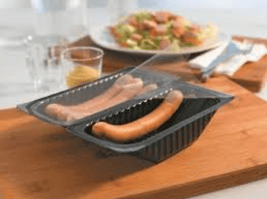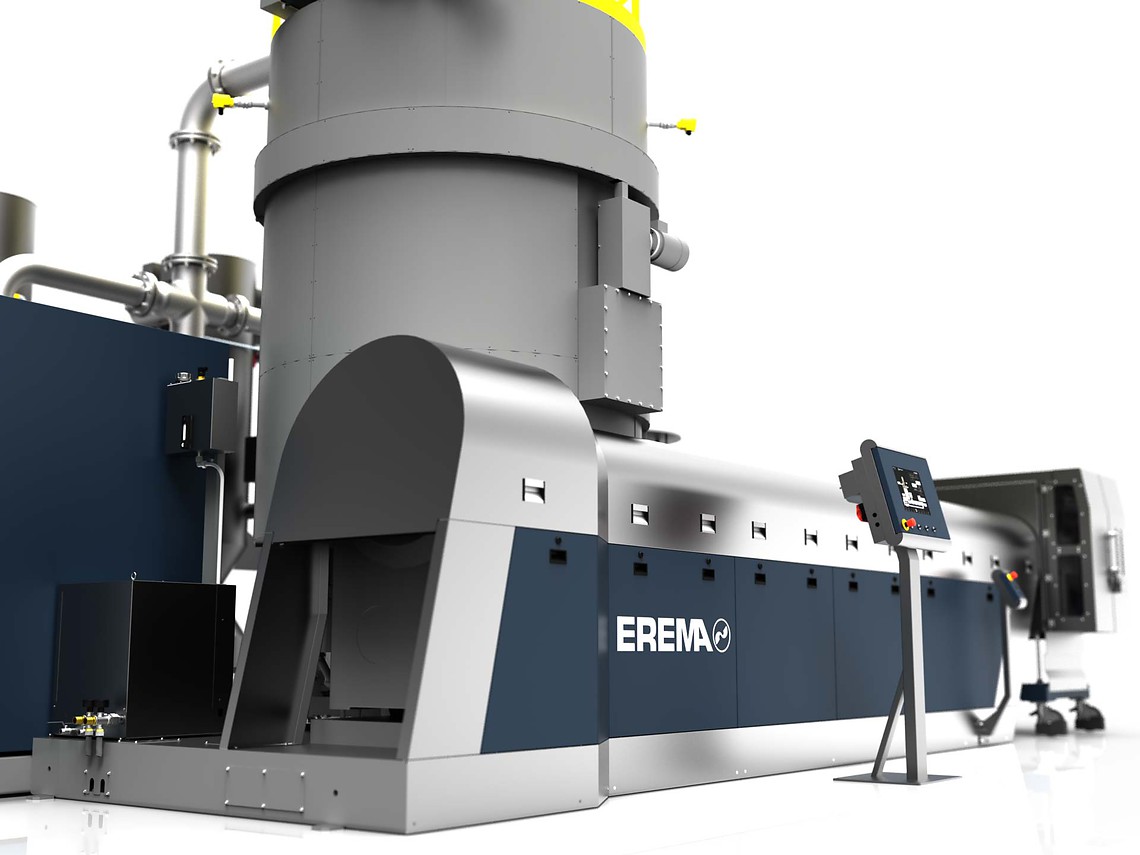PET (polyethylene terephthalate) is widely used for food packaging. It comes in two forms, Amorphous and Crystalline. Except for some microwave food trays which use Crystalline PET, most of the PET packaging products that you come into contact with are APET or Amorphous PET.
APET is used for packaging because it’s strong which makes for durable packaging that can protect the product while also being lightweight which is good for shipping costs. Perhaps most importantly, studies have shown that clear packaging which allows consumers to easily see the product at point of purchase increases sales, so being very clear is an advantage from a marketing perspective of using PET products in packaging, particularly food packaging.
RPET is recycled PET. Producing a food grade (suitable for food contact), very clear RPET can be a challenge.
Buergofol is a leading manufacturer of PET films for food packaging. Their films are used for product bags as well as the ‘top film’ to seal food packages such as fish and meats containers that are meant for refrigeration.
They’ve been producing top film for packages for over 40 years. Many of their top films are laminated to solve specific packaging problems. The bottom layer of a packaging top film might be tacky around the edge to allow for package resealing. The middle layer might provide stiffness or strength and the top layer might be suitable for color printing.
"One of our specialities is the manufacturing of 3-layer PET film with a middle layer made of post-consumer material," or RPET, explains CEO Gregor Schleicher.
Why Use RPET?
"Sustainability is of course a very important topic for us, but this is just one of the reasons why we process RPET material with this technology.” Says Gregor Schleicher, Technical Managing Director, Buergofol.
Using an RPET layer saves money because in-house scrap such as edge trim can be diverted back into the manufacturing process. Equally important, RPET film has an advantage in this application. RPET films are a bit stiffer than virgin APET films. This improves thermoformability and also saves material cost and weight. A 220 µm film made of RPET, is about as stiff as a 260 µm film made of virgin PET material.
Examples of Food Packaging Incorporating RPET


Examples of Food Packaging Incorporating RPET
How is RPET Processed?
In addition to their in-house recycling of scrap material (sometimes called post-industrial recycling), Buergofol sources washed bottle flakes from single-use PET bottles collected from the bottle deposit system.
To process the post-consumer bottle RPET flakes, material mixtures are produced first in large silos and scrap in-house materials are also added. "Some of our customers also mix the RPET material with up to 30 percent virgin PET material," explains Christoph Wöss, Business Development Manager - Application Bottle at EREMA.

Advanced RPET Processing Technology by EREMA
In the case of Buergofol the RPET mixture goes from the silo via a vacuum conveyor into a sluice. From the sluice, the material is moved into a vacuum stage. Vacuum treatment of RPET removes moisture as well as off-gassing other contaminants. The time/pressure parameters must be closely controlled as there needs to be sufficient dwell time at sufficient vacuum to ensure decontamination of the material, which allows for food contact use.
The RPET material is heated up to a temperature of around 190°C by friction. Three processes occur while heating of the RPET takes place. First, there is crystallisation, which ensures that the flakes do not stick to each other in the further processing. Then there is moisture removal. The outside moisture of post-consumer RPET material is between 0.3 and 1 per cent. This evaporates at the temperature inside the reactor within seconds or a few minutes." The inside moisture of the RPET at around 0.2 to 0.3% is likewise removed, thus ensuring that hydrolysis cannot occur and the chain length of the polymer molecules is not shortened. "Finally there is the third process of decontamination. Contaminants are likewise discharged as a result of the high temperature and removed reliably by the vacuum which is applied.
Christoph Wöss of Buergofol mentions another benefit of the reactor: "PET Bottles have become increasingly thinner especially just recently, due to ecological and economical reasons, meaning that the bulk density of the RPET flakes is decreasing more and more. This, in turn, is bad for the extruder later on." In the heat there is a bulk density increase of around 250 kg/m3 to 500 kg/m3. The material leaves the reactor after about two hours and is fed into a single-screw extruder with a diameter of 212 mm.
The single-screw extruder now handles the task of melting the prepared RPET material at a temperature of around 280°C and conveying it through a piston filter which retains the solid contaminants and into the flat sheet die.
"This complete RPET process has a multitude of benefits, especially for the processing of post-industrial raw PET materials," says Gregor Schleicher of Buergofol. "The RPET flakes are completely freed from moisture and contaminants at relatively moderate temperatures and are clean when they enter the single-screw extruder. Here they are only exposed to the high temperatures very briefly due to the pre-cleaning, which has a positive impact on the RPET material properties. He is of the opinion that this system is better compared to the multiple screw systems without preparation. This solution is also good in terms of energy, as shown by research projects at the SKZ institute. "The specific electricity consumption of the EREMA RPET solution is lowest in comparison to alternative systems."
After the flat sheet die the RPET film is cooled down in the SML calender and laminated directly inline if required. "We work with thermolamination, so without additional adhesive," emphasises Kurt Stark. Buergofol attaches great importance in general to inline thermolamination, which is not very common for PET/RPET film. "We have designed our inline laminating stations and integrated them in the systems as a whole ourselves so far."
SML has now directly integrated the laminating station in the new plant which will again be a combination of an EREMA recycling system and an SML cast part. "The RPET machine technology has progressed," says the delighted PET/RPET film manufacturer, who is very proud that they produce all the films specified by the market themselves apart from OPET and OPP films. In order to ensure that the film products satisfy the customers' wishes, Buergofol operates a fully equipped test laboratory and a thermoforming technical centre. "This is where we reproduce the processes of our customers," says Gregor Schleicher in conclusion.
The company has placed an order for the second complete VACUREMA® RPET processing system.
You can see advanced RPET technology in action here!
You can learn about advanced RPET processing technology here.
EREMA also produces PET bottle-to-bottle recycling systems which save time, energy and space in achieving RPET recycling objectives at large scale.
EREMA RPET Technology Example















